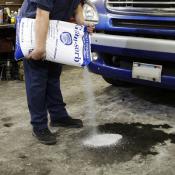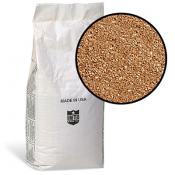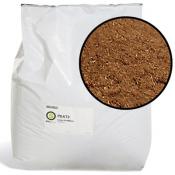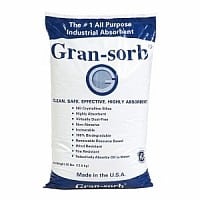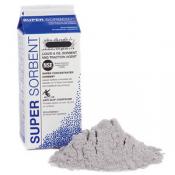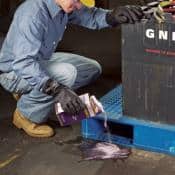What are Absorbent Granules and How Can They Help With Workplace Spill Cleanup?
Granular absorbents make cleaning up water, gas, antifreeze, oil spills, and other chemicals a breeze. Simply sprinkle these loose absorbents directly on top of the liquid. The granules immediately begin to soak up the spill, hence the name: granular absorbent.
After absorbing most of the fluid, collect, bag, and dispose of the soaked granular materials. It’s an incredibly easy and effective solution for cleaning up liquid and chemical spills in the workplace.
But how do loose granular absorbents compare to other products, like absorbent mats, when it comes to spill control? A key benefit of loose absorbents is that they easily reach anywhere a spill can go. For instance, cracks, gaps, corners, and porous surfaces. Some loose granular products are even suitable to smother flash oil fires. Their small textured pallets can also improve traction. Not only keeping floors clean and dry but reducing slipping accidents and hazards.
There are well over half a dozen different types of granular absorbents on the market. While each of them serves one sole purpose — to absorb liquid spills — some prove to be better than others. Familiarize yourself with the subtle differences between each granular before making a purchase.
What are the different types of granular absorbents?
Loose granular absorbents come in several different material options. You can also choose different packaging and dispensers, such as poly bags, pails, and shaker cartons. Each type has its own absorbency properties and liquid spill use applications. We’ll outline a few of them, next.
Corn Cob
As the name implies, these absorbent granules contain the ground remnants of corn cobs. Which means it’s environmentally friendly and also bio-degradable, too.
This highly effective universal absorbent is able to hold 4 times its weight in fluid. Whether you’re dealing with oil, antifreeze, or plain water, you can rest assured knowing corn cob granules will do the job.
Peat Moss
Made from Sphagnum moss, this all-natural granular is particularly effective for cleaning oils. Just 2 cubic feet of this stuff will absorb approximately 16 gallons of spilled oil. Throw it over the spill, then sweep it up – simple!
As well as being super-absorbent, it’s also lightweight, with a non-abrasive texture. And is a great choice for oil spills that are outdoors, such as on soil. It’s important to note, however, that Peat Moss does not absorb water.
Gran-Sorb
A top seller at AbsorbentsOnline.com, Gran-Sorb contains cellulose materials left over from paper mill processing. It offers a dust-free formula that is 100% biodegradable.
Versatile Gran-Sorb has a 1:1 absorbency ratio and is for universal applications. Use it on oil, lubricants, gasoline, antifreeze, coolants, solvents, water, and many other liquids.
Super Sorbent
This lightweight and inert formulation is another one of our best sellers. As a universal absorbent, it instantly soaks up a variety of liquids including oils, coolants, and solvents. It is also dust-free and fireproof, with a melting point of more than 3900 F.
One 2lb carton absorbs about half a gallon of liquid. The convenient dispenser lets you easily shake the contents directly over spills. Making it ideal for routine maintenance tasks and small leaks.
Kitty Litter
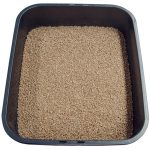
Save the kitty litter for your cat’s use only!
The name is self-explanatory; kitty litter is the same stuff used to absorb cat urine. Cat litter formulas typically contain silica-based diatomaceous earth, or, conventional clay.
The primary benefit of using kitty litter is its inexpensive price tag, but that doesn’t necessarily mean it’s the best choice. In addition to being heavy, clay and silica compounds are known to cause health risks.
Clay’s rough texture also has the potential to scratch and damage floors or expensive machinery. It can often be sticky, messier to use, and to pick up afterward. Unlike other all-purpose absorbent granular alternatives.
In short, we suggest you leave this stuff where it belongs: in your pet’s litter tray!
Specialty Loose Sorbents
In addition to the above, several other specialized granular compounds and neutralizer powders are available. And are often the key components of specialty spill kits. For instance, to clean up bodily fluids, acids, hazmat and chemical spills.
See our previous posts on how to respond to acid spills and cleaning up liquid mercury for more information.
What’s the best granular absorbent?
The U.S. Federal Emergency Management Agency (FEMA) conducted a test to determine which granular absorbents are the most effective. They found cellulose, such as Gran-Sorb, to be the most effective for absorbing oil, fuel, and antifreeze. Meanwhile, sorbents made with Peat Moss and Polypropylene came in a close second.
“Cellulose insulation was the material that absorbed the most oil, fuel, and antifreeze; however, it also absorbed the most water. Polypropylene and Peat Moss also did well with absorption percentages for oil, fuel and antifreeze above seventy percent of their volume,” wrote the Federal Emergency Management Agency (FEMA) in a study conducted on the efficiency of various granular absorbents.
How do I safely dispose of granular absorbents?
After soaking up a spill, use a broom to sweep and collect the soiled granular materials. Then, place them in an appropriate waste receptacle or bag.
Depending on the liquid or chemical spill type, it’s often possible to incinerate products like Gran-Sorb. Which can be a great way to help reduce your business waste disposal expenses. And also minimizes the chance of chemicals leeching into landfills.
Always refer to the safety data sheet (SDS) disposal recommendations for specific details.
Find affordable spill-control supplies
We are here for all your workplace spill containment and cleanup needs. Take advantage of our competitive pricing on spill kits, absorbent pillows, pads, and more. Talk to your absorbent product experts, today!
Have questions about which spill containment or absorbent products are best for your facility? Contact Travis Zdrazil at travis@absorbentsonline.com or (800) 869-9633.
This is a revision to a blog post with an original publication date of May 15, 2014
